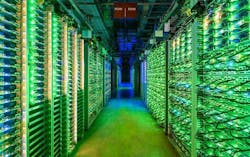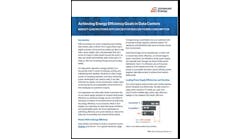After a record year for cloud growth in 2021, data center developers are building even bigger in 2022. And nearly half of the data centers being built are leased before they are even completed.
The ongoing growth for the data center sector was outlined in new reports from CBRE, JLL and Synergy Research, who say that demand from hyperscale operators specializing in cloud computing and social media will continue to drive massive investment in digital infrastructure in 202 and beyond.
- There was a record 493.4 megawatts (MW) of net absorption of data center space in the seven primary U.S. markets in 2021, according to CBRE’s latest North American Data Center Trends Report. That’s a 31% increase over the previous record total from 2019, and up 50% from 2020, according to CBRE’s numbers.
- JLL had a broader snapshot but also saw record growth, reporting absorption reaching a mammoth total of 885.7 MW across 14 domestic markets, due to an impressive second half of 2021 led by large cloud and technology company expansions. This absorption figure is a 44.3 percent increase year-over-year.
“We expect continued strong data center demand from cloud service providers and social media companies in 2022 as these firms race to build out their digital infrastructure to support demand for cloud services and metaverse and other digital communities,” said Pat Lynch, Executive Managing Director, Data Center Solutions, CBRE.
Data center inventory in those top markets grew 17% year-over-year, even as the vacancy rate fell to just 7.2%, suggesting demand was outpacing new construction. There’s plenty of new space on the way, as developers have 727.6 MW of facilities under construction, according to CBRE. That’s 147 percent of the record leasing volume from 2021, yet it’s clear that there is plenty of demand. CBRE reports that about 44 percent of that space under construction – about 320 megawatts – has been pre-leased.
“More 100+ MW leases will be signed, as purpose-built data centers attract single-tenant occupiers with growing data requirements,” said CBRE. “These large-scale requirements likely will remain driven by cloud service providers and ever-growing social media companies.”
“There are now more 20+ MW requirements than there are 1 MW requirements,” said JLL in its 2021 Year-End Data Center Outlook. “Available landsites in key data center markets have been limited due to competing industrial demand, power deployment constraints and supply chain issues for critical infrastructure. This has resulted in hyperscale users competing for data center space that can accommodate large-scale growth that was previously unheard of (i.e., 36+ MW requirements).”
Synergy: 300 More Hyperscale Data Centers Coming
That aligns with data from Synergy Research, which forecasts rapid growth in the number of large data centers for hyperscale operators. Synergy says these companies plan to build at least 314 future new hyperscale data centers. The installed base of hyperscale data centers will pass 1,000 in three years’ time, Synergy says. and will continue growing rapidly thereafter.
For validation of that trend, look no farther than Meta, which announced two new data center campuses in the past week, unveiling an $800 million campus in Kansas City and another $800 million campus in Temple, Texas. Both announcements come just a month after Meta unveiled a new $800 million campus in Idaho.
There’s more of that type of expansion in the pipeline, according to Synergy.
“The future looks bright for hyperscale operators, with double-digit annual growth in total revenues supported in large part by cloud revenues that will be growing in the 20-30% per year range,” said John Dinsdale, Chief Analyst at Synergy Research Group. “This in turn will drive strong growth in capex generally and in data center spending specifically. We predict continued rapid growth throughout the hyperscale data center ecosystem. Companies who can successfully target that ecosystem with their product offerings have plenty of reasons for optimism.”
The research is based on an analysis of the data center footprint and plans of 19 of the world’s major cloud and internet service firms, including the largest operators in IaaS, PaaS, SaaS, search, social networking, e-commerce and gaming. Synergy said the companies that feature most heavily in the future new data center pipeline are Amazon, Microsoft, Facebook and Google.
Synergy said market dynamics like geographic distribution, build-versus-lease, and average data center size are “all continuing to evolve.”
Northern Virginia Sees Most Absorption
One criteria that will continue to guide the site selection for data centers is sustainability, a trend we highlighted in DCF’s 2022 Forecast.
“The availability of clean power will have to increase exponentially as data centers move toward carbon neutrality,” noted CBRE. “More industry players are beginning to consider the option of nuclear power, although there are concerns over its sustainability.”
Northern Virginia remained the most active data center market with net absorption in 2021, with CBRE reporting 303.3 MW of absorption while JPP reported 338 MWs in 2021 — more than four times that of Atlanta, the second-most-active market. There was some variability in which markets came next, with CBRE touting Atlanta as second-best with 70 MWs of absorption, while JLL reporting 142 MWs of absorption in the Phoenix market as second-best.
On the construction front, JLL noted robust building plans in Northern California, which leads its summary with 205 MWs in the pipeline, edging out Northern Virginia (200 MWs). CBRE cites Northern Virginia has having the largest under-construction pipeline at 239 MW, followed by Hillsboro, Oregon (234.8 MW) and Atlanta (160.5 MW).
Here’s a look at CBRE’s summary of the key data points for the top seven U.S. data center markets in 2021:
Source: CBRE






